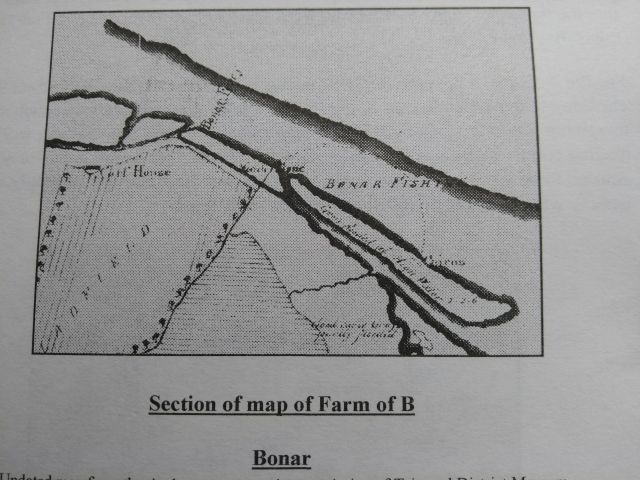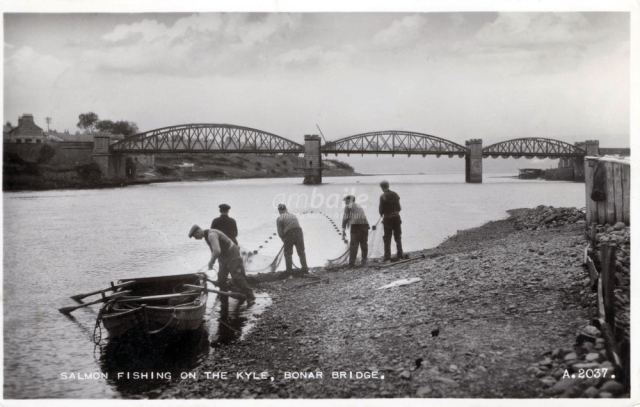When I visit Bonar Bridge, it’s my habit to walk along the front street and back again to see what’s happening in the place. In April last year I was doing this and looking across the Kyle but with an uneasy sense that something was not quite right. Where was the bothy? Had I gone mad or misremembered? But no; as I looked more carefully, I saw the large mound of earth where the bothy had stood.
Filled with shock and rage, I started making enquiries.

In Sarah Horne’s book, she says that the salmon fishing of Bonay (sic) was described as early as 1582 in the Balnagown papers which are currently in Tain Museum. A corf house is a small building used for curing salmon and for storing nets and other fishing equipment.

Could the building just visible here on the south side of the bridge, in this aquatint by Daniell dated 1821, be the corf house or the bothy as it came to be called locally? The other possibility is that the building is the Ardross Hotel, which later became known as South Bonar, but I don’t know when it was built. Nor do I know enough about the exact location of the first bridge in relation to where the second one stood but it can’t have been too far away from where “Bonar ferry” was marked on the undated map. The map shows “Bonar fishing” but this was east of the bridge site, near the old ice house below where Kyle House is now.

The picture above was taken from near the bothy – or salmon netting station, to give it its official title – and it shows the fishing as I remember it in the 1960s, 1970s, 1980s. Uncle John was the manager and Corriemulzie Estate was then the owner. Many generations of Bonar men were employed at the fishing and crowds of tourists stood on the roadside on the opposite bank in the summer time, watching the process. Most of the salmon was sent off south by train from Ardgay station but some folk bought it locally and one of them was James Robertson Justice who had a house at Spinningdale. One summer day, Uncle John casually remarked that Gina Lollobrigida had been in the bothy with JRJ buying salmon; she was a guest down at Spinningdale.
The netting came to an end in the late 1980s. In a letter to The Northern Times in 2013, the late Sandy Chalmers bemoaned that this was done with “absolutely no consultation, discussion or involvement of the local people”. In 2013, he was protesting about the sale of the fishing rights but he also referred back to what had happened to the netting station. His phrases then about lack of consultation have become my phrases now.

As this picture above shows, the bothy was abandoned and nothing was done to stop the building deteriorating. To the right, you can see the windlasses and beyond them, one of the boats was left for the grass to grow through.
 These windlasses and some of the old nets, I believe, are now in the possession of the Kyle of Sutherland Fisheries Board – the current owners of the site and the people responsible for the destruction of the bothy.
These windlasses and some of the old nets, I believe, are now in the possession of the Kyle of Sutherland Fisheries Board – the current owners of the site and the people responsible for the destruction of the bothy.

The old coble, to the right, abandoned to nature.
The decision to demolish the bothy was taken by the KOS Fisheries Board in 2016. It had been offered to the local angling club but they could not afford to renovate and maintain it. The Board say they contacted Highland Council to check whether there were any legal impediments but on being told the building was not listed, the demolition went ahead. No attempts were made to consult with local people or even inform them. They were about to destroy the oldest building in the area and one which had been at the centre of the local village economy but no, this did not need to be a matter for any wider discussion. The opportunity for a community effort to save and restore the bothy was therefore lost.
The minutes of the Fisheries Board meeting for June 2018 show that three formal complaints had been received about the “destruction of the old netting store”. The response was that it had not been used for many years – true. It was in a poor state of repair – whose fault was that? Its condition was unsafe so the option to repair and reuse it was unviable – did none of them think about involving the local community or trying to get funding from a heritage body?
The Board were sorry if they had caused “any upset” but claimed they had acted purely to ensure the safety of the public. They admitted there had been a lack of consultation and agreed there was a need to put mechanisms in place to ensure community consultation in the future. They were interested in supporting the idea of a museum or visitor centre and could allocate land for it but they were not able to provide funding as their money had to be used to protect the fish population. They were able to provide funding however to pay for asbestos removal from the roof of the bothy and for demolition costs and I suspect that several members of the Board are local estate owners with very deep pockets.
The formal complaints were not upheld.
Their next meeting took place in October 2018. Further complaints from members of the public were made at this meeting but these too were disregarded. The chairperson declared that there had been “no malice” in the Board’s actions and he apologised again for the lack of community consultation although this apology was negated to my mind when he went on to state there had been “no alternative” to destruction and the outcome would likely have been the same even if the community had been consulted. How could he possibly know that? Once again, he insisted that it had been a Health & Safety issue due to the dangerous condition of the building.
Between June and October last year, there had been a meeting with the Kyle of Sutherland Development Trust at which the Fisheries Board representatives had learned that any rebuilding at the original site would not receive planning permission “due to flooding issues”. How then did the Hub, just a few hundred yards away and at the same level, get permission? The Development Trust have a proposed project for an area nearby that will include “some signage and heritage interpretation on the history of the netting industry”. The possibility of putting up some information boards was first mentioned at the meeting in June last year, as if a few boards soon to weather and decay were going to compensate for the loss of a possible heritage centre sited in an original building.
The issue came up again at a Fisheries Board meeting last month. Once again, the chairperson insisted that the outcome of the various complaints was that the Board would be looking at better ways of communicating and engaging with the community. Although they were not a “heritage agency”, they did have an educational remit and would be progressing this at an upcoming meeting with a local heritage society.
This is a sorry saga of neglect and decay and ignorance and lack of respect for the built heritage of the area and the local culture by a few people who have a great deal of power but very little sense of community responsibility.

The bothy, above, in July 2015 and below, in 2016 when the eastern section had already been demolished. Both pictures taken by Iain Gillies.


Yes, I often stopped by for a look. ( my family were involved in netting in many places – we were catching them by the 10s of thousands – sorry ).
I have a photo taken on the day they were on the roof removing the asbestos ( but very ‘grainy’. And then one with bare timbers. I often looked at the cobles, there were three in various stages of rot. I have a small piece at home. It shows the thickness was only 1/2″ ( a sea-going coble was nearer 1″ ).
LikeLike
Hello Peter,
Thanks for reading and replying. Would you be able to attach your photos to your comment?
When the work was happening on the roof, many local folk thought the building was going to be re-roofed! How I still wish that someone had investigated what was going on and had then raised the alarm so at least there would have been a chance of saving the building.
LikeLike
Hi Bella,
I’ve not been to Bonar Bridge since my parents took me there as a 5 year old, way back in the late 60s, but something stirred this morning on a day off from work, and I began looking for the netting station. I found a photograph by Donald Bain, the close-up you have above, and it was amazing, exactly as I remembered it (obviously notwithstanding the damage of time). I remember going up those stairs with my dad to buy a piece of Salmon for dinner (we were camping at Dornoch Beach), and I remember too, wooden crates of salmon lying on the grass. Such a shame that those salmon are now an endangered species, and also such a shame that a small piece of the memories of thousands upon thousands of adults my age has been obliterated.
Best wishes,
Graham Walker
LikeLiked by 1 person
Thanks Graham. Glad you have some happy memories of being at the bothy in its heyday; you’d likely have met our Uncle John in there as he was one of the fishermen – not sure when he became the manager. And yes, I share your pain at the destruction.
LikeLike